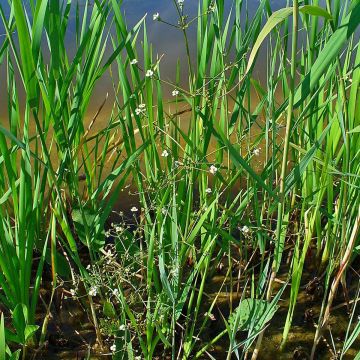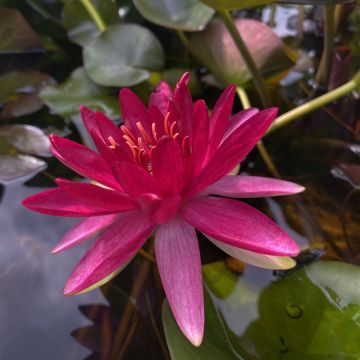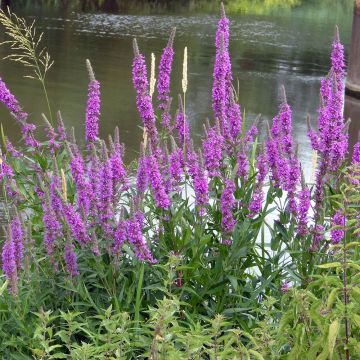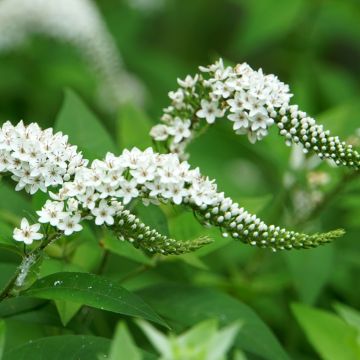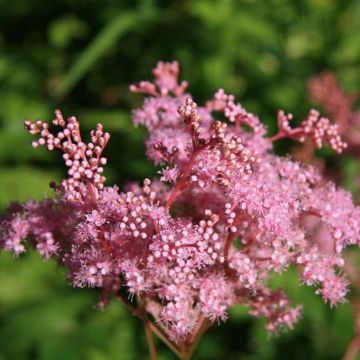

Lemna minor - Common Duckweed
Lemna minor - Common Duckweed
Lemna minor
Common Duckweed, Lesser Duckweed, Water Lentils, Water Lens
This plant carries a 12 months recovery warranty
More information
We guarantee the quality of our plants for a full growing cycle, and will replace at our expense any plant that fails to recover under normal climatic and planting conditions.
From €5.90 for pickup delivery and €6.90 for home delivery
Express home delivery from €8.90.
Does this plant fit my garden?
Set up your Plantfit profile →
Description
Lemna minor, also known as the Lesser Duckweed, is one of the most common species of cosmopolitan duckweed, as it is found in slow and stagnant waters in most countries in Africa, Asia, Europe, and North America. It is a small floating aquatic plant with oval leaves measuring a few millimeters. Deciduous, it spends the winter underwater and resurfaces in spring. This species thrives in bright light and easily colonizes freshwater with high nitrate levels and rich in organic matter. Excessive proliferation can hinder the proper development of rooted aquatic plants, depriving them of light. It is reserved for use in aquariums where certain species may appreciate the filtered and diffuse light under a blanket of duckweed.
Lemna minor belongs to the arum family. While this floating aquatic perennial is very common in calm waters worldwide, it is absent from Arctic and subarctic climates and high mountains. It reproduces rapidly when exposed to suitable sunlight and temperature. In certain contexts, this duckweed has strong potential for water purification and as organic fertilizer or food, but it can also quickly bioaccumulate certain non-biodegradable pollutants and transfer them to other compartments of the environment. It is a small floating plant, kept afloat by an internal air reserve. Its oval leaves measure 1 to 8 mm long and 0.6 to 5 mm wide. They are light green on the upper surface and darker on the lower surface. The lower surface is flat or slightly undulate. Each mature leaf bears a single central root (usually 1 to 2 cm long); this root, white to greenish, almost always descends vertically into the water. On each individual, small buds sprout from the leaves and eventually separate to form a new plant. In cool and temperate zones, when the water temperature drops below 6 to 7 °C, the duckweed produces starch granules that are stored in a structure called a "turion". The plant dies, and the turion sinks into the water where it will spend the winter. In spring or early summer, a seedling forms and grows, floating on the surface, and the seasonal cycle begins again.
Lemna minor can be used in aquaria to purify water and create less illuminated submerged areas, appreciated by certain species of plants or fish. It is important not to use it in open natural environments, where it is considered harmful and has an impact on biodiversity. Its rapid proliferation leads to the formation of dense mats on the water surface, preventing the penetration of light and gas exchange between air and water. This can result in the asphyxiation of the environment, which is highly detrimental to other species (fauna and flora), as well as the rapid accumulation of organic matter that cannot be degraded without oxygen. Duckweeds also absorb mineral salts in large quantities and therefore tend to impoverish the aquatic environment.
Report an error about the product description
Flowering
Foliage
Plant habit
Botanical data
Lemna
minor
Araceae
Common Duckweed, Lesser Duckweed, Water Lentils, Water Lens
Western Europe
Other Aquatic perennials
Planting and care
Add the water lentil to the surface of aquariums. Its growth is optimal at a pH between 6.5 and 7.5 (although it can tolerate water with a pH between 5 and 9). Temperatures should be between 6 and 33 °C. It is therefore very tolerant in terms of medium.
Given its proliferation capabilities, remove a portion every year. Removing some of its mass every year helps prevent eutrophication of the basin (excessive nitrate, sediment, etc.). It is a way to balance the environment.
Planting period
Intended location
Care
This item has not been reviewed yet - be the first to leave a review about it.
Aquatic plants
Haven't found what you were looking for?
Hardiness is the lowest winter temperature a plant can endure without suffering serious damage or even dying. However, hardiness is affected by location (a sheltered area, such as a patio), protection (winter cover) and soil type (hardiness is improved by well-drained soil).

Photo Sharing Terms & Conditions
In order to encourage gardeners to interact and share their experiences, Promesse de fleurs offers various media enabling content to be uploaded onto its Site - in particular via the ‘Photo sharing’ module.
The User agrees to refrain from:
- Posting any content that is illegal, prejudicial, insulting, racist, inciteful to hatred, revisionist, contrary to public decency, that infringes on privacy or on the privacy rights of third parties, in particular the publicity rights of persons and goods, intellectual property rights, or the right to privacy.
- Submitting content on behalf of a third party;
- Impersonate the identity of a third party and/or publish any personal information about a third party;
In general, the User undertakes to refrain from any unethical behaviour.
All Content (in particular text, comments, files, images, photos, videos, creative works, etc.), which may be subject to property or intellectual property rights, image or other private rights, shall remain the property of the User, subject to the limited rights granted by the terms of the licence granted by Promesse de fleurs as stated below. Users are at liberty to publish or not to publish such Content on the Site, notably via the ‘Photo Sharing’ facility, and accept that this Content shall be made public and freely accessible, notably on the Internet.
Users further acknowledge, undertake to have ,and guarantee that they hold all necessary rights and permissions to publish such material on the Site, in particular with regard to the legislation in force pertaining to any privacy, property, intellectual property, image, or contractual rights, or rights of any other nature. By publishing such Content on the Site, Users acknowledge accepting full liability as publishers of the Content within the meaning of the law, and grant Promesse de fleurs, free of charge, an inclusive, worldwide licence for the said Content for the entire duration of its publication, including all reproduction, representation, up/downloading, displaying, performing, transmission, and storage rights.
Users also grant permission for their name to be linked to the Content and accept that this link may not always be made available.
By engaging in posting material, Users consent to their Content becoming automatically accessible on the Internet, in particular on other sites and/or blogs and/or web pages of the Promesse de fleurs site, including in particular social pages and the Promesse de fleurs catalogue.
Users may secure the removal of entrusted content free of charge by issuing a simple request via our contact form.
The flowering period indicated on our website applies to countries and regions located in USDA zone 8 (France, the United Kingdom, Ireland, the Netherlands, etc.)
It will vary according to where you live:
- In zones 9 to 10 (Italy, Spain, Greece, etc.), flowering will occur about 2 to 4 weeks earlier.
- In zones 6 to 7 (Germany, Poland, Slovenia, and lower mountainous regions), flowering will be delayed by 2 to 3 weeks.
- In zone 5 (Central Europe, Scandinavia), blooming will be delayed by 3 to 5 weeks.
In temperate climates, pruning of spring-flowering shrubs (forsythia, spireas, etc.) should be done just after flowering.
Pruning of summer-flowering shrubs (Indian Lilac, Perovskia, etc.) can be done in winter or spring.
In cold regions as well as with frost-sensitive plants, avoid pruning too early when severe frosts may still occur.
The planting period indicated on our website applies to countries and regions located in USDA zone 8 (France, United Kingdom, Ireland, Netherlands).
It will vary according to where you live:
- In Mediterranean zones (Marseille, Madrid, Milan, etc.), autumn and winter are the best planting periods.
- In continental zones (Strasbourg, Munich, Vienna, etc.), delay planting by 2 to 3 weeks in spring and bring it forward by 2 to 4 weeks in autumn.
- In mountainous regions (the Alps, Pyrenees, Carpathians, etc.), it is best to plant in late spring (May-June) or late summer (August-September).
The harvesting period indicated on our website applies to countries and regions in USDA zone 8 (France, England, Ireland, the Netherlands).
In colder areas (Scandinavia, Poland, Austria...) fruit and vegetable harvests are likely to be delayed by 3-4 weeks.
In warmer areas (Italy, Spain, Greece, etc.), harvesting will probably take place earlier, depending on weather conditions.
The sowing periods indicated on our website apply to countries and regions within USDA Zone 8 (France, UK, Ireland, Netherlands).
In colder areas (Scandinavia, Poland, Austria...), delay any outdoor sowing by 3-4 weeks, or sow under glass.
In warmer climes (Italy, Spain, Greece, etc.), bring outdoor sowing forward by a few weeks.








































